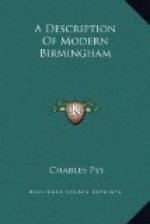Aldridge, in Staffordshire, nine miles.
The principal road from Birmingham to Stafford lay through this village, until of late years the turnpike road through Walsall and Cannock having been considerably improved, this road to the county town is nearly if not quite abandoned; yet it leads to Hednesford (usually pronounced Hedgeford), where numerous horses are annually trained for the turf, upon Cannock heath. To Edgbaston, in Warwickshire, distant one mile.
Having passed up Broad-street and Islington, when you are through the turnpike, the left hand side of Ladywood-lane, the whole of Hagley-row, the road to Harborne, Calthorpe’s road, and the right hand side of Islington-row, are all of them in this parish. Indeed the lands hereabouts are almost exclusively the property of Lord Calthorpe, whose ancestors purchased this estate, early in the last century for L25,000, and he will not permit any manufactories to be established upon his land which tends in a great degree to make the neighbourhood respectable and genteel.
The first Houses in Calthorpe’s-road were erected in the year 1815; the establishment for the deaf and dumb being erected about two years before. This asylum is under the superintendance of Mr. Braidwood, and is described among the public institutions in Birmingham.—(See page 39.)
There were, in former times, within this parish, three parks, Edgbaston-park, Mitchley-park, and Rotten-park, but the two latter have many years since been thrown into inclosures. The park of Edgbaston remains entire, and the mansion within it is now the residence of Edward Johnson, M.D. who is very eminent in his profession.—The church is an ancient gothic tower, the body having of late years been very much modernized, and fitted up withinside in a very neat and commodious manner. The officiating clergyman is the Rev. Charles Pixell. There have been within the last three years a great number of genteel houses erected by the opulent inhabitants of Birmingham, who not only enjoy fresh air, but the parochial taxes of this parish do not bear any proportion with those of Birmingham. At this toll-gate, which bears the name of Five-ways, there are now, by the opening of Calthorpe’s road, six separate and distinct roads. About half a mile from the toll-gate, there is on the right of the Hagley road, an observatory, a very conspicuous pile of building, seven stories high, which is usually called the Monument: it was erected by John Perrot, Esq. about the year 1758, from whence there are extensive views over the adjacent country, in every direction. The adjoining house is the residence of John Guest, Esq.
There was in this church-yard a grave-stone, cut by the hands of that celebrated typographer, Baskerville, (who was originally a stone-cutter, and afterwards kept a school in Birmingham), which is now removed and placed withinside the church. The stone being of a flaky nature, the inscription is not quite perfect, but whoever takes delight in looking at well-formed letters, may here be highly gratified: it was erected to the memory of Edw. Richards, an idiot, who died 21st September, 1728, with the following inscription :—




